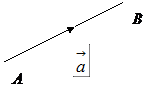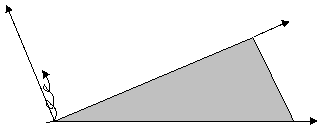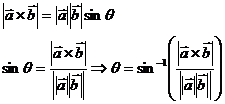MATHS :: Lecture 23 :: Vectoralgebra
![]()
Vector Algebra
A quantity having both magnitude and direction is called a vector.
Example: velocity, acceleration, momentum, force, weight etc.

Vectors are represented by directed line segments such that the length of the line segment is the magnitude of the vector and the direction of arrow marked at one end denotes the direction of the vector.
A vector denoted by ![]() =
= ![]() is determined by two points A, B such that the magnitude of the vector is the length of the line segment AB and its direction is that from A to B. The point A is called initial point of the vector
is determined by two points A, B such that the magnitude of the vector is the length of the line segment AB and its direction is that from A to B. The point A is called initial point of the vector ![]() and B is called the terminal point. Vectors are generally denoted by
and B is called the terminal point. Vectors are generally denoted by ![]() (read as vector a, vector b, vector c,…)
(read as vector a, vector b, vector c,…)
Scalar
A quantity having only magnitude is called a scalar.
Example: mass, volume, distance etc.
Addition of vectors
If ![]() and
and ![]() are two vectors, then the addition of
are two vectors, then the addition of ![]() from
from ![]() is denoted by
is denoted by ![]() +
+ ![]()
This is known as the triangle law of addition of vectors which states that, if two vectors are represented in magnitude and direction by the two sides of a triangle taken in the same order, then their sum is represented by the third side taken in the reverse order.

Subtraction of Vectors
If ![]() and
and ![]() are two vectors, then the subtraction of
are two vectors, then the subtraction of ![]() from
from ![]() is defined as the vector sum of
is defined as the vector sum of ![]() and -
and - ![]() and is denoted by
and is denoted by ![]() -
- ![]()
![]()
![]() -
- ![]() =
=![]() +(-
+(- ![]() )
)
Types of Vectors
Zero or Null or a Void Vector
A vector whose initial and terminal points are coincident is called zero or null or a void vector. The zero vector is denoted by ![]() .
.
Proper vectors
Vectors other than the null vector are called proper vectors.
Unit Vector
A vector whose modulus is unity, is called a unit vector.
The unit vector in the direction of ![]() is denoted by
is denoted by ![]() . Thus
. Thus ![]() .
.
There are three important unit vectors, which are commonly used, and these are the vectors in the direction of the x, y and z-axes. The unit vector in the direction of the x-axis is![]() , the unit vector in the direction of the y-axis is
, the unit vector in the direction of the y-axis is ![]() and the unit vector in the direction of the z-axis is
and the unit vector in the direction of the z-axis is ![]() .
.
Collinear or Parallel vectors
Vectors are said to be collinear or parallel if they have the same line of action or have the lines of action parallel to one another.
Coplanar vectors
Vectors are said to be coplanar if they are parallel to the same plane or they lie in the same plane.
Product of Two Vectors
There are two types of products defined between two vectors.
They are (i) Scalar product or dot product
(ii) Vector product or cross product.
Scalar Product (Dot Product)
The scalar product of two vectors ![]() and
and ![]() is defined as the number
is defined as the number![]()
![]() , where
, where ![]() is the angle between
is the angle between ![]() and
and ![]() . It is denoted by
. It is denoted by![]() .
.![]() .
.
Properties
- Two non-zero vectors
 and
and  are perpendicular if
are perpendicular if 
\ ![]() .
.![]() = 0
= 0
- Let
 be three unit vectors along three mutually perpendicular directions. Then by definition of dot product,
be three unit vectors along three mutually perpendicular directions. Then by definition of dot product,  and
and 
- If m is any scalar,
 =
= =
=
- Scalar product of two vectors in terms of components
Let ![]() :
: ![]() .
.
Then ![]()
= ![]() +
+ ![]() +
+
![]()
= a1b1 + a2b2 + a3b3 ![]()

![]()
- Angle between the two vectors

![]() .
.![]() =
= ![]()
![]()

Work done by a force:
Work is measured as the product of the force and the displacement of its point of application in the direction of the force.
Let ![]() represent a force and
represent a force and ![]() the displacement of its point of application and
the displacement of its point of application and ![]() is angle between
is angle between ![]() and
and![]() .
.
![]() .
. ![]() =
= 
Vector Product (Cross Product)
The vector product of two vectors ![]() and
and ![]() is defined as a vector
is defined as a vector ![]() sin
sin ![]() , where
, where ![]() is the angle from
is the angle from ![]() and
and ![]() ,
, ![]() is the unit vector perpendicular to
is the unit vector perpendicular to ![]() such that
such that ![]() form a right handed system. It is denoted by
form a right handed system. It is denoted by ![]() . (Read:
. (Read: ![]() )
)

A
![]()
![]()
![]()
![]()
![]() B
B
Properties
1. Vector product is not commutative
![]()
= ![]()
![]()
![]()
2. Unit vector perpendicular to ![]()
![]() ………(i)
………(i)
![]()
![]() ………(ii)
………(ii)
(i) ¸ (ii) gives ![]() =
= ![]()
3. If two non-zero vectors ![]() are collinear then
are collinear then ![]()
![]()
Note
If ![]()
![]() then (i)
then (i) ![]() =
=![]() ,
,![]() is any non-zero vector or
is any non-zero vector or
(ii) ![]() =
=![]() ,
,![]() is any non-zero or
is any non-zero or
(iii) ![]() and
and ![]() are collinear or parallel.
are collinear or parallel.
4. Let ![]() be three unit vectors, along three mutually perpendicular directions. Then by definition of vector product
be three unit vectors, along three mutually perpendicular directions. Then by definition of vector product ![]()
![]()

5. (m![]() ) x
) x ![]() =
= ![]() x (m
x (m![]() ) = m(
) = m(![]() x
x ![]() )where m is any scalar.
)where m is any scalar.
6. Geometrical Meaning of the vector product of the two vectors is the area of the parallelogram whose adjacent sides are ![]() and
and ![]()
Note
Area of triangle with adjacent sides ![]() =
=![]()
![]() x
x ![]() )
)
7. Vector product ![]() in the form of a determinant
in the form of a determinant
Let ![]() =
=![]()
Then ![]() =(
=( ![]() ) x (
) x (![]() )
)
= 
8. The angle between the vectors ![]()

Moment of Force about a point
The moment of a force is the vector product of the displacement ![]() and the force
and the force ![]()
(i.e) Moment ![]()
![]()
| Download this lecture as PDF here |
![]()